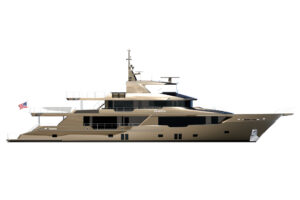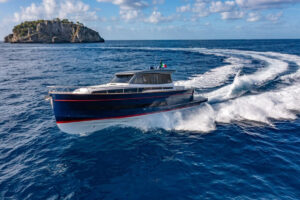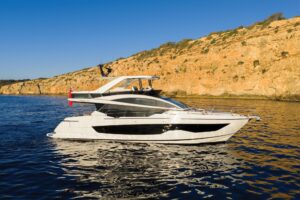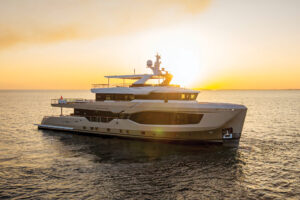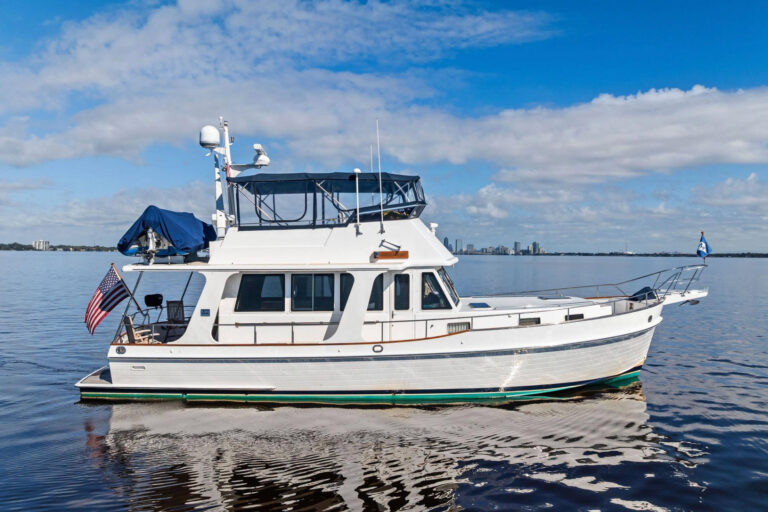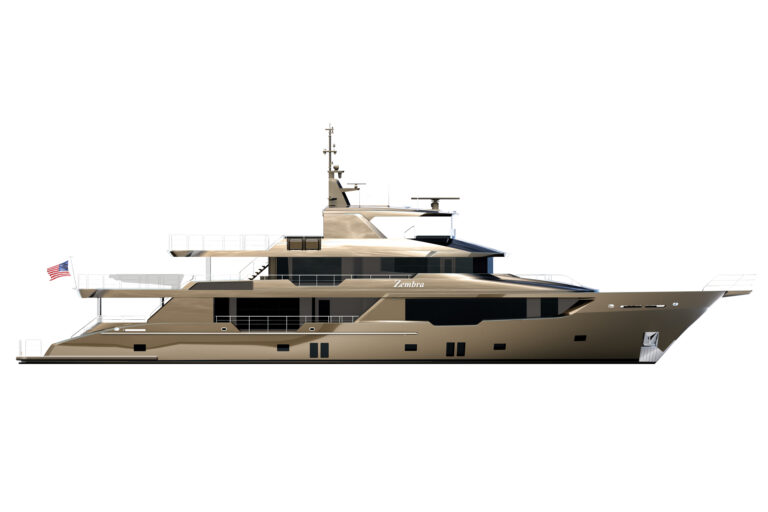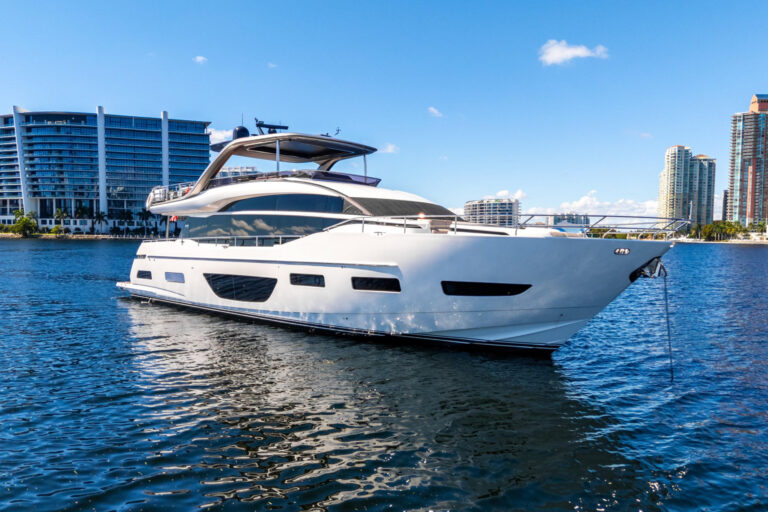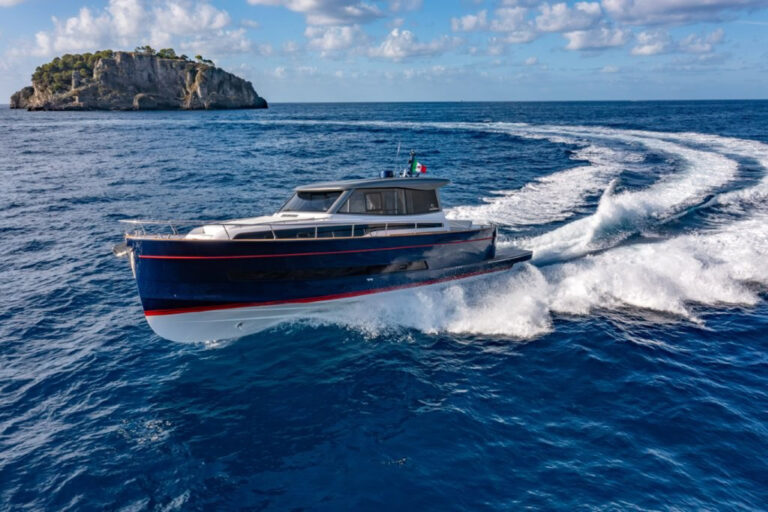

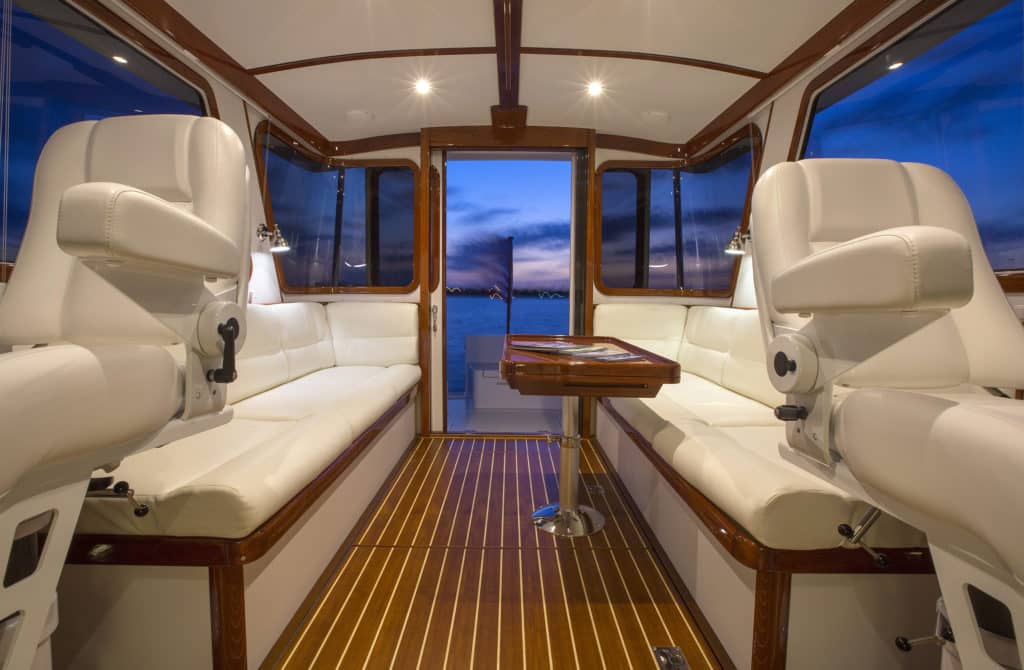
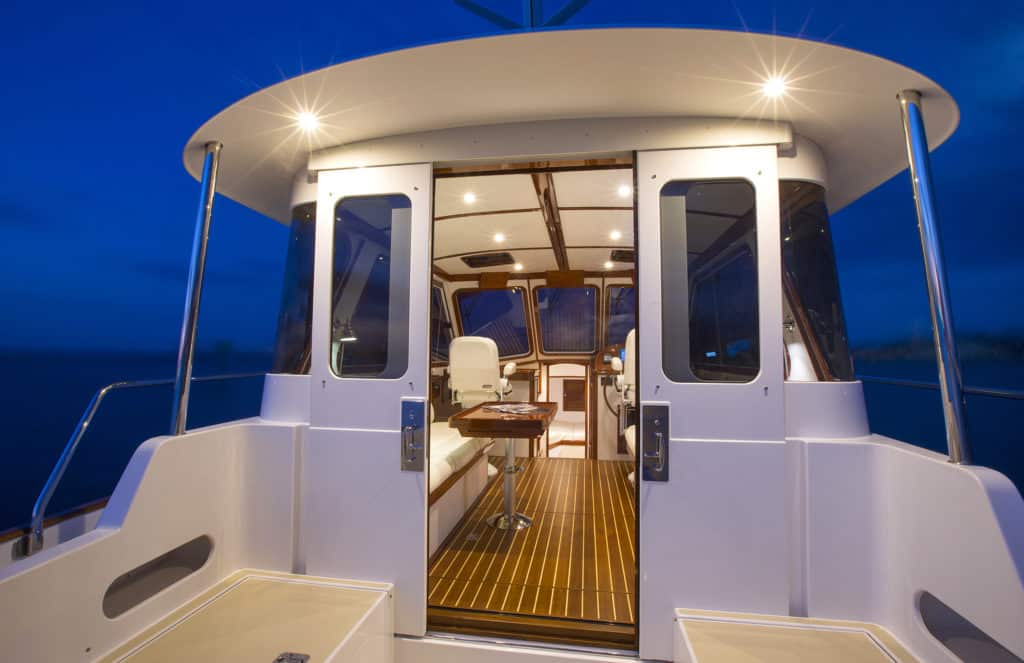
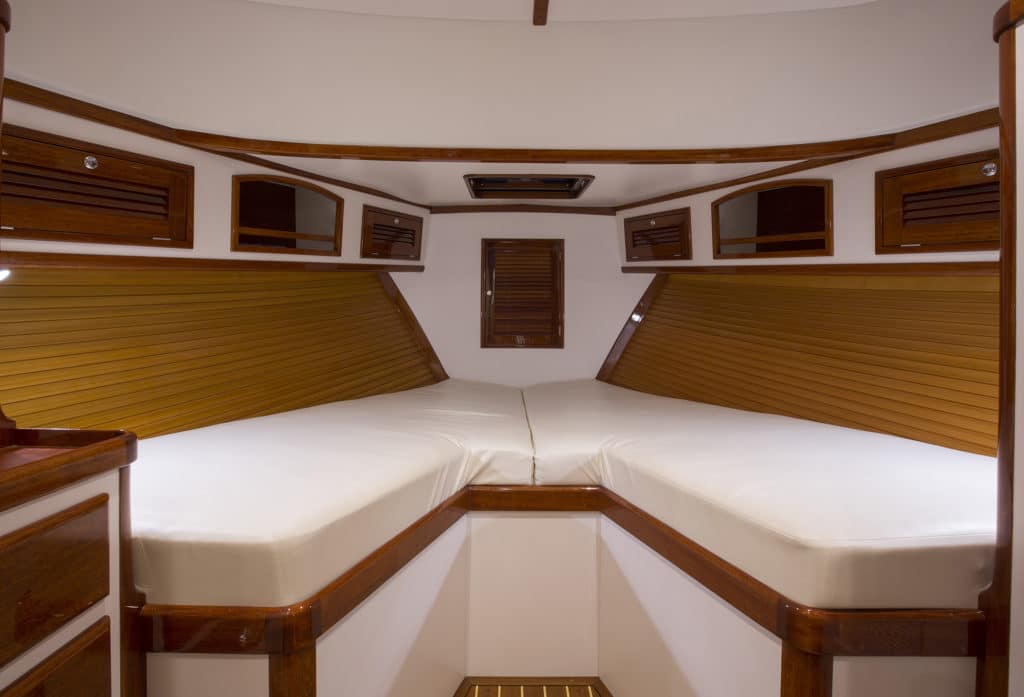


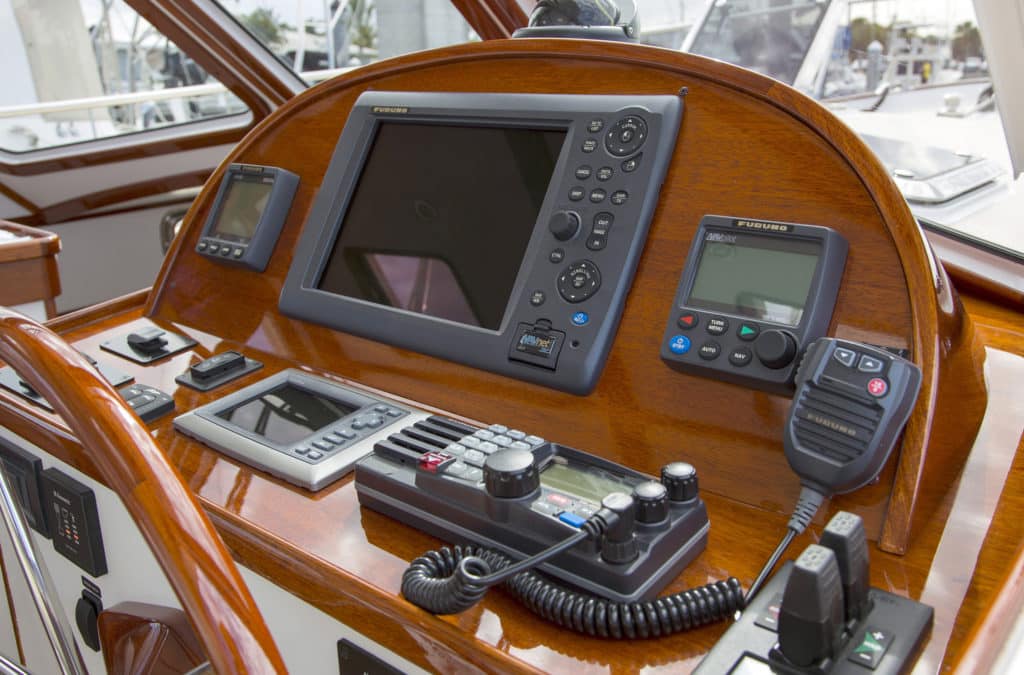




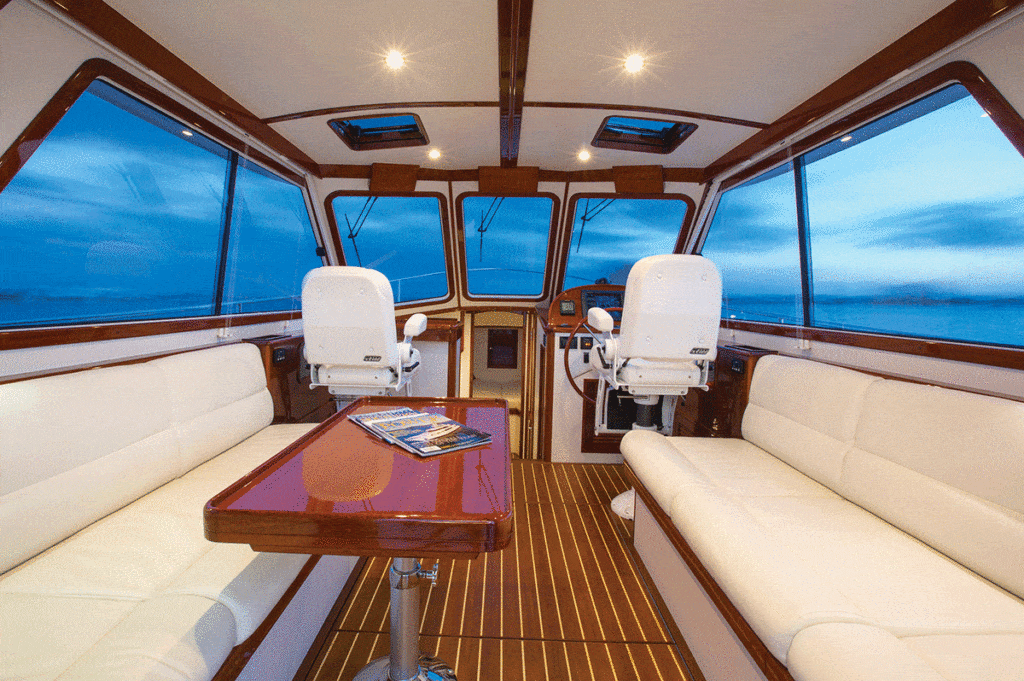
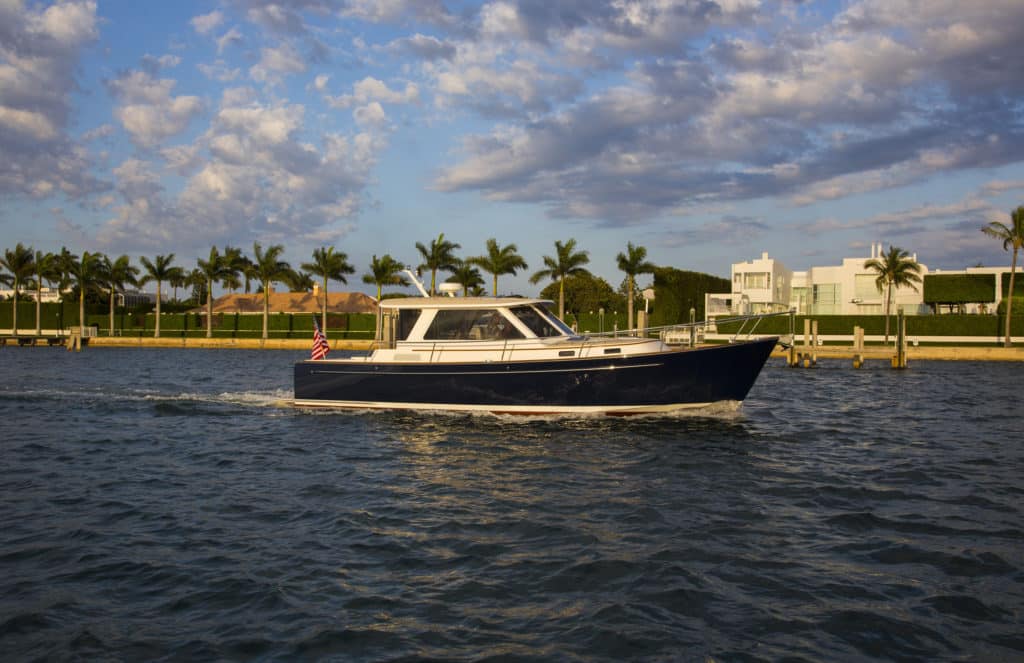
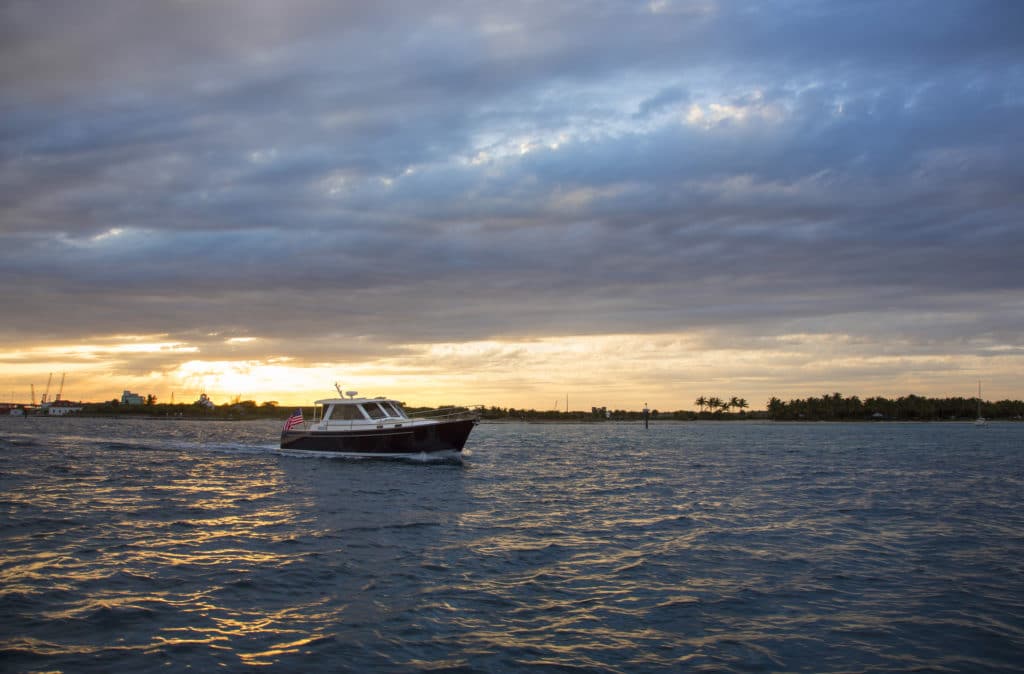
Early October on the Connecticut River near Essex seduces visiting cruisers. Once you see this lovely valley, you won’t be able to resist a return. Among the most seductive conveyances for exploring the river has to be the Abaco 40. Designed by Mark Ellis and built by Bruckmann Yachts, this very New England-style yacht fits her purpose like a well-worn Top-Sider.
She has all the accouterments a person needs to be comfortable wrapped in a package that refuses to go out of style. What’s more, her ride, handling and tactile steering rekindle the joy of being one with a boat.
I saw her for the first time at the Newport International Boat Show in September and briefly explored her simple interior. Dressed in white with mahogany trim, her accommodations felt homey and comfortable. I looked forward to getting aboard and was pleased to get Ellis’ invitation a month later to sea-trial her.
At the show, the Abaco 40 had been tucked into a corner, and no one could get enough distance from her to appreciate her aesthetics. On the day of my run, she was moored to a face dock at the Essex Island Marina, showing off her sweeping sheer line and proud deckhouse.
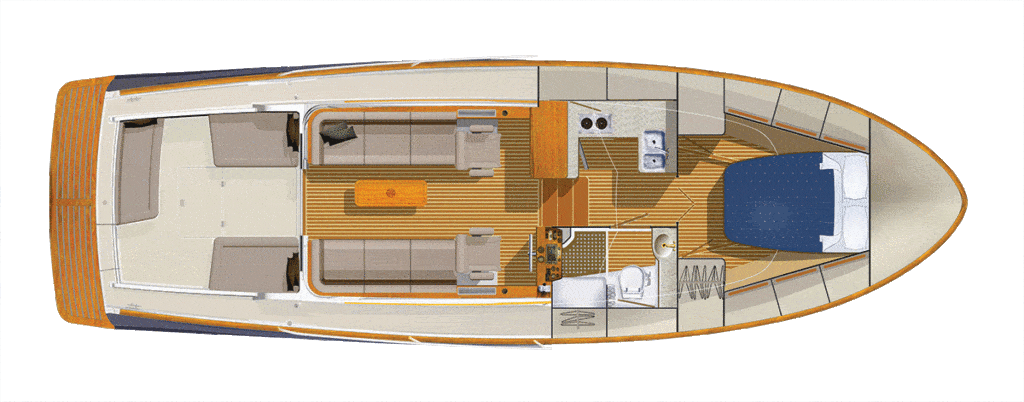
Ellis drew the trunk cabin, forward of the house, the way he always does — to look as though it would be comfortable on a sailing yacht. He rolled the shoulders at the front of the structure in a graceful arc of larger radius than you’ll find on most boats of this type. It’s a small element, but it makes the Abaco 40 look more elegant than many of her competitors.
When I saw her in Newport, I thought that the house was too high relative to the boat’s length overall. Seeing her from a bit of distance, and with the river as background, made me think that her proportions are actually ideal.
From a practical point of view, the tall house provides a lot of headroom in the salon and more than you’d imagine in the engine room located beneath. And the large windows provide super sight lines. The side windows slide open from their forward end. Hatches in the overhead help with ventilation, but when the weather turns hot and humid, the owners can engage the air-conditioner.
The symmetrical layout of the salon recalls those found on traditional sailboats. This couple plans to use this 40 called Alize V for daylong outings and overnighting, perhaps entertaining guests for cocktails, lunch or dinner, so the long settees — and a fold-out dining table on the port side — perfectly suit their purpose.
| Specifications | Builder Supplied Numbers |
|---|---|
| LOA: | 39’3″ |
| BEAM: | 12’9″ |
| DRAFT: | 3’11” |
| DISPL: | 19,000 lb. |
| WATER: | 80 gal. |
| FUEL: | 300 gal. |
| WASTE: | 30 gal. |
| ENGINE (tested): | 1 x 670 hp Cummins QSM11 diesel |
| ENGINES (opt.): | 2 x 380 hp Cummins QSB w/ ZF pods or straight shafts |
| PRICE (as tested): | $888,535 w/ std. engine |
| BASE PRICE: | $789,500 w/ single diesel |
Those settees may double as berths to accommodate overnight guests or one of the owners if making an overnight passage. I liked the look and ambience of the salon and easily pictured myself lounging, book propped on my lap and a single malt within easy reach on the table.
Three steps lead to the galley down, head and stateroom. The steps lift on gas-filled struts to give access to the engine room. The U-shaped galley is tight enough to be seamanlike, but it isn’t cramped.
Its 12-volt refrigerator opens at the front and seemed able to hold all the perishable stores and cold drinks the owners will need — likewise the top-loading 12-volt freezer. A microwave and two-burner ceramic cooktop ought to give the chefs all they require to prepare tasty meals aboard.
Anyone on galley duty during daylight hours will bask in natural light from the pilothouse’s windshield above. Alize‘s owners chose a V-berth for their stateroom, but a queen-size island is also available.
Aircraft-style lockers located outboard of and above the cedar ceilings can hold all manner of small items. A bureau of drawers at the foot of the berth on the port side will swallow folded clothing, and a cedar-back hanging locker opposite seemed spacious enough for a blazer, slacks, a few dresses and dry foul-weather jackets. A louvered door at the head of the berth opens onto the anchor-chain locker. The white overhead and bulkheads, plus good lighting, keep the area belowdecks from feeling like a dungeon.
The stellar day beckoned, so John Plumb, our skipper for the day, ignited the big, 670 hp Cummins diesel, and we cast off our lines. Bruckmann offers Side-Power variable-speed thrusters fore and aft, allowing the helmsman to walk Alize gently and accurately sideways from the dock.
These thrusters also will spin the boat around her vertical center of gravity as though she were a top, albeit a lot more slowly. We idled into the river’s channel and headed north.
When our captain opened the throttle to its stop, the big four-blade prop bit into the water and hustled us along at a satisfying gallop. I love the instantaneous response a prop provides.
Alize rose to plane in a few seconds. I say “rose” because she didn’t lift her bow the way most planing hulls do, but instead climbed as a unit, bow and stern in concert. Carefully calculated weight distribution partly accounts for this behavior, but more important is the shape of her bottom — the extraordinarily wide chine flats that Ellis began to develop about 15 years ago.
He begins with a conventional deep-V bottom, which has about 20 degrees of deadrise aft. A conventional deep-V relies on an abundance of power, a handful of strakes on each side of the keel and smallish chine flats outboard of the V-sections to hoist the boat onto plane.
These hulls run economically and comfortably at high speeds in a wide variety of sea states, and they do well at displacement speed. They don’t, however, like the transition from displacement to planing speed during acceleration or deceleration.
The Abaco 40’s wide chines provide the lift that lets the boat plane at just 8 knots, whether she’s decelerating or accelerating. And her wake, the way the water separates from the transom, tells the story. This hull is most efficient at about 15 knots.
| RPM | KNOTS | GPH | dB(A) |
|---|---|---|---|
| 600 | 6.3 | 1.2 | 69 |
| 900 | 8.8 | 3.2 | 74 |
| 1200 | 11.3 | 7.0 | 77 |
| 1500 | 16.1 | 12.1 | 81 |
| 1800 | 20.5 | 17.4 | 82 |
| 2100 | 25.2 | 25.7 | 86 |
| 2300 | 28.4 | 33.0 | 89 |
A substantial skeg allows her to track, unattended, in a straight line for an uncommonly long period of time, even in beam seas. The autopilot is nearly redundant. The skeg also protects the prop and rudder. Probably the most remarkable handling characteristic is the 40’s ability to corner without leaning into or away from the turn’s radius.
Bruckmann also offers the 40 with twin 380 hp Cummins QSB diesels spinning ZF pods or straight shafts. He gets the deep-V shape sections aft by laminating the hull in the original tooling. A dam inserted into the Abaco 40’s mold creates a delta-shaped flat along the centerline of the bottom back aft, and provides for the skeg on the single-engine model.
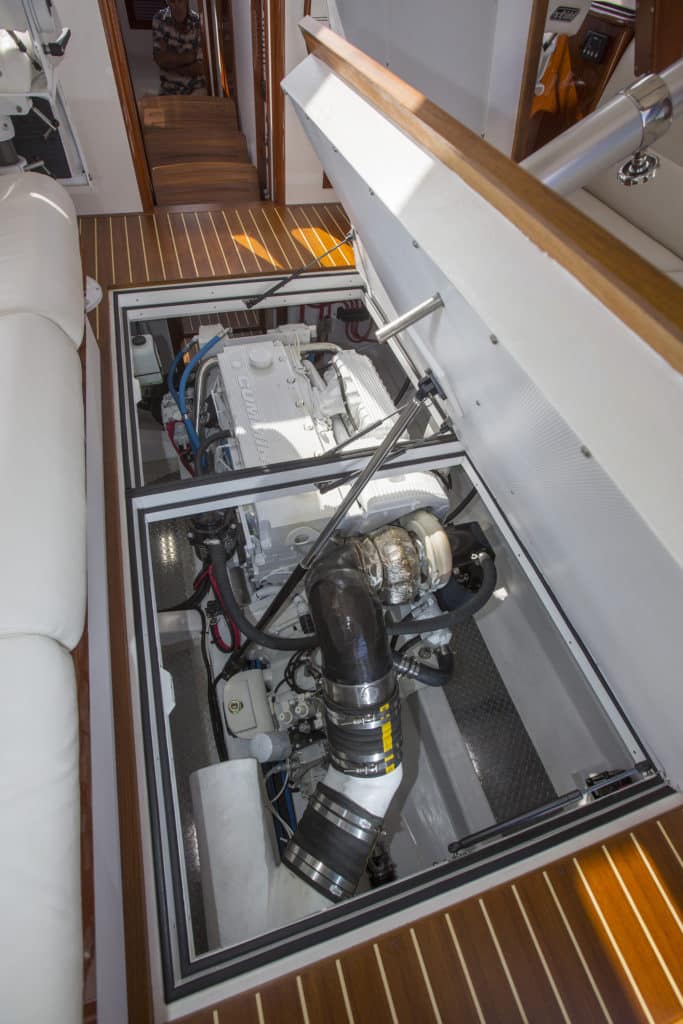
The deadrise on each side of this flat is the same as the deep-V bottom, but cutting away the V allows a shallower prop-shaft angle. Also, the angle of the gear box’s output shaft causes Bruckmann to mount the single engine slightly nose down, so at planing speeds the engine is parallel to the waterline.
The Abaco 40 enticed me with her honesty, straightforward performance and traditional accommodations.
The overhead handrail in the salon; the way Bruckmann changed the radius of the curved windows in the after corners of the salon to deal with the tumblehome in the house; the molded fiberglass doors between the cockpit and salon, all near perfection.
And like the river we ran her on, this yacht will likely seduce those who are fortunate enough to see her.

